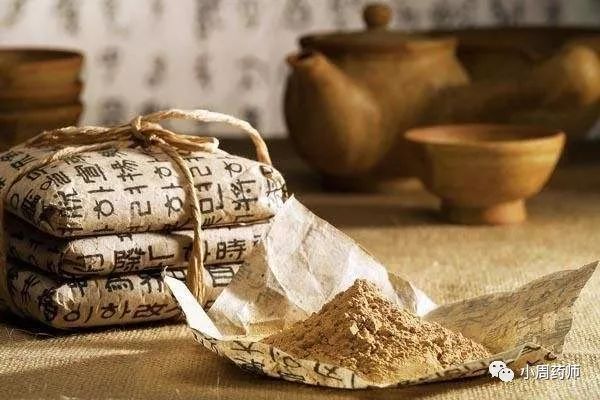Hello everyone, I am Pharmacist Xiao Zhou. Today we will begin discussing the various formulations. Many of the topics overlap with Western medicine, but there are also unique formulations in Traditional Chinese Medicine (TCM), such as powders, pills, and decoctions. These new concepts require our careful understanding.
Knowledge Point: Section Three: Powder Formulations
1. Characteristics of Powder Formulations:
Powder formulations have the following characteristics: they have a larger specific surface area, which facilitates dispersion and absorption, leading to rapid effects;they are easy to prepare; they provide a certain mechanical protective effect on wounds when applied externally; they are commonly used in dentistry, otolaryngology, trauma, and surgery, and are suitable for pediatric administration. However, due to their larger specific surface area, powders are prone to moisture absorption, and the chemical activity of the drug components can increase, leading to loss and oxidation. Therefore, drugs that are hygroscopic or prone to oxidation, highly irritating drugs, and those with a high content of volatile components should not be made into powder formulations.
2. Classification of Powder Formulations Powder formulations can be classified based on medical use, composition, properties, and dosage. (1) By medical use: they can be divided into internal and external powder formulations. (2) By drug composition: they can be classified as single herb powders and compound powders. (3) By drug properties: they can be classified as ordinary powders and special powders. Special powders can be further divided into those containing toxic herbs, those with low eutectic components, and those containing liquid components. (4) By dosage: they can be classified as dose-specific powders and non-dose-specific powders. Dose-specific powders are packaged by single doses; non-dose-specific powders are packaged by total doses for multiple uses, with patients taking their doses as prescribed. Dose-specific powders are mostly for internal use, while non-dose-specific powders are mostly for external use.
3. Quality Requirements for Powder Formulations (1) Regulations on the production and storage of powders 1. Unless otherwise specified, internal powder formulations should be fine powders; pediatric and external powders should be the finest powders.
2. When preparing powders containing toxic herbs, precious herbs, or those with small doses, the mixing method should be used, and they should be sieved.
3. Multi-dose packaged powders should include dosing tools; internal powders containing toxic herbs should be packaged in single doses.
4. Unless otherwise specified, powders should be stored in a sealed manner; powders containing volatile drugs or those prone to moisture should be stored in airtight containers.
5. To prevent gastric acid from destroying the active components in biological product powders, neutralizing components can be added to the diluents of the powders;
6. For burns, if they are not sterile preparations, the label should indicate “non-sterile preparation,” and they should only be used for mild burns.
(2) Quality inspection items and requirements for powders ① Particle size: For external powders used for burns or severe wounds, unless otherwise specified, the total amount of powder passing through a No. 7 sieve should not be less than 95% (the finest powder).
|
Fine Powder |
All pass through a No. 5 sieve and contain at least 95% of powder that can pass through a No. 6 sieve |
|
The Finest Powder |
All pass through a No. 6 sieve and contain at least 95% of powder that can pass through a No. 7 sieve |
② Uniformity of appearance: should have uniform color, without patterns or color spots. ③ Moisture: Unless otherwise specified, it should not exceed 9.0%.④ Dose variation ⑤ Dose ⑥ Sterility: for burns, severe wounds, and clinical necessity. ⑦ Microbial limits
Practice Questions:
1. Unless otherwise specified, the powder fineness for internal powder formulations is
Unless otherwise specified, the powder fineness for pediatric powders is
Unless otherwise specified, the powder fineness for external powders is
A. Coarse Powder
B. Medium Powder
C. Fine Powder
D. The Finest Powder
E. Extremely Fine Powder
2. Unless otherwise specified, the moisture content of powders should not exceed
A. 0.08
B. 0.09
C. 0.1
D. 0.11
E. 0.12
Answers and Explanations:
1.C D D
The herbs and extracts used for powder formulations should be crushed. Unless otherwise specified, internal powders should be fine powders; pediatric and external powders should be the finest powders (D is correct). Extremely fine powders (E is incorrect) are generally required for eye preparations.
2. B
According to the moisture determination method in the “Chinese Pharmacopoeia,” unless otherwise specified, the moisture content of powders should not exceed 9.0% (B is correct).
Pharmacist Xiao Zhou says:
The content on powder formulations is relatively limited. Remember a few key points: one is which types of drugs are not suitable for making powders based on their properties; the second is the fineness of powders for external, internal, and pediatric use; the third is the moisture content requirement, which is 9%. Exam questions generally revolve around these three points.


